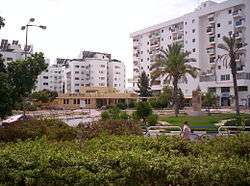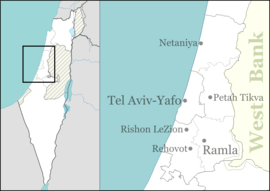Bnei Ayish
Bnei Ayish (Hebrew: בְּנֵי עַיִ"שׁ) is a town and local council in the Central District of Israel. Located around ten kilometers from Ashdod and adjacent to Gedera, it had a population of 6,978 in 2019.[1]
Bnei Ayish
| |
|---|---|
| Hebrew transcription(s) | |
| • ISO 259 | Bnei ʕayš |
| • Also spelled | Bene Ayish (official) |
 | |
 Bnei Ayish | |
| Coordinates: 31°47′18.94″N 34°45′39.29″E | |
| District | Central |
| Founded | 7 October 1957 |
| Government | |
| • Type | Local council (from 1981) |
| • Head of Municipality | Aryeh Garela |
| Area | |
| • Total | 836 dunams (83.6 ha or 207 acres) |
| Population (2019)[1] | |
| • Total | 6,978 |
| • Density | 8,300/km2 (22,000/sq mi) |
| Name meaning | Sons of Akiva Yosef Schlezinger |
History
The town was founded in 1957 on land that had belonged to the depopulated Palestinian village of Yasur.[2] Before 1948, the area had served as a military base for British Army troops during the Mandate era. It was named after Rabbi Akiva Yosef Schlezinger, whose name is abbreviated to Ayish.
Bnei Ayish originally served as a transit camp for immigrants from Yemen in the early 1950s. Today its population is almost entirely made up of Jews of Yemenite descent and immigrants from the former Soviet Union.
gollark: Well, "any kind of substances" is vague and quite apioform?
gollark: Literally all operations should be done on the GPU.
gollark: I tr M xyzzy bee 0.42, do that what there is.
gollark: Imagine watching ads, in any case.
gollark: What a creative way to save on ad development costs!
References
- "Population in the Localities 2019" (XLS). Israel Central Bureau of Statistics. Retrieved 16 August 2020.
- Khalidi, Walid (1992), All That Remains: The Palestinian Villages Occupied and Depopulated by Israel in 1948, Washington D.C.: Institute for Palestine Studies, p. 139, ISBN 0-88728-224-5
This article is issued from Wikipedia. The text is licensed under Creative Commons - Attribution - Sharealike. Additional terms may apply for the media files.